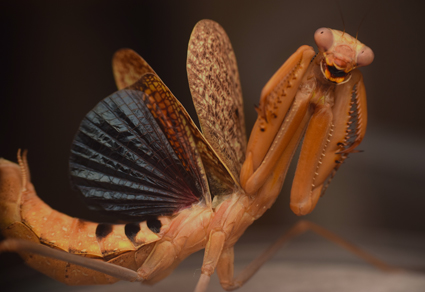Abstract
A recent reinvigorated effort into examining morphology and ecology of Nearctic Mantodea has led to the description of nearly 10 new species in the past decade. Expeditions to southern Arizona, combined with iNaturalist observations, suggested that S. wheelerii sensu Anderson is a complex of at least two cryptic species across its extensive range. Herein I describe one new species: Stagmomantis clauseni sp. nov., the Sonoran Tiger Mantis, from the Sonoran and Chihuahuan deserts, utilizing citizen science contributions, comparative morphology, and captive observations to describe its ontogeny and ethology. In addition, I also redescribe Stagmomantis wheelerii (Thomas 1875) and document the holotypes of Stagmomantis colorata (Hebard 1922) for the first time. The development of Stagmomantis clauseni sp. nov. also warranted the description of new hatching and signaling systems in Mantodea. For ease of both citizen and professional scientists a dichotomous key is provided for members of the subgenus Nigralora including characters in life.
References
- Agudelo, A.A., Lombardo, F. & Jantsch, L.J. (2007) Checklist of the Neotropical mantids (Insecta, Dictyoptera, Mantodea). Biota Colombiana, 8, 105–158.
- Anderson, K. (2018) Praying mantises of the United States and Canada. 2nd Edition. Independently published, Las Vegas, Nevada, 297 pp.
- Anderson, K. (2020) Revision of Stagmomantis Saussure, 1869. Soothsayer: Journal of Mantodea Research, 1 (1), 9–18.
- Anderson, K. (2021) Revision of the Nearctic genus Litaneutria Saussure, 1892. Soothsayer: Journal of Mantodea Research, 2 (1), 1–85.
- Anderson, K. (2022) Revision of the North American genus Bistanta. Soothsayer: Journal of Mantodea Research, 3 (1), 1‒47.
- Connors, M.G., Yeeles, P., Lach, L. & Rentz, D.C. (2023) A revision of the genus Ima Tindale (Mantodea: Nanomantidae: Fulciniinae) with the description of a new genus. Zootaxa, 5380 (3), 201–226.
- https://doi.org/10.11646/zootaxa.5380.3.1
- Garikipati, L. & Bond, J.E. (2021) A checklist of Mantodea of Belize, with a regional key to species. ZooKeys, 1068, 51. https://doi.org/10.3897/zookeys.1068.58193
- Garikipati, L. (2023) Observational reports of oviposition differences in geographically disparate populations of S. limbata (Hahn, 1835)―Non-consumptive effects of invasive competitors. Soothsayer: Journal of Mantodea Research, 4 (1), 62–69.
- Hahn, C.W. (1835) Icones Orthopterum: Abbildungen der hautflügligen Insecten. Verlag der zinkographischen Anstalt, Nürnberg, 5 pp.
- Hafner, D.J. & Riddle, B.R. (2011) Boundaries and barriers of North American warm deserts. In: Upchurch, P., McGowan, A.J. & Slater, S.C.S. (Eds.), Palaeogeography and palaeobiogeography biodiversity in space and time. Systematics Association Special Volume Series 77. CRC Press, Taylor and Francis Group, Boca Raton, Florida, pp. 75–114. https://doi.org/10.1201/b11176-5
- Hebard, M. (1922) Dermaptera and Orthoptera from the state of Sinaloa, Mexico: Part I. Dermaptera and non-saltatorial Orthoptera. Transactions of the American Entomological Society, 48 (3), 157–196.
- Hebard, M. (1931) Studies in Lower Californian Orthoptera. Transactions of the American Entomological Society, 57 (1), 113–128.
- Hebard, M. (1935) Studies in the Orthoptera of Arizona. Part II. A list of the Dermaptera and Orthoptera of Arizona with new records and corrections of the literature subsequent to 1900. Transactions of the American Entomological Society, 61 (3), 269–316.
- Rehn, J.A.G. & Hebard, M. (1909) An orthopterological reconnaissance of the Southwestern United States. Part III: California and Nevada. Proceedings of the Academy of Natural Sciences of Philadelphia, 61 (3), 409–483. [http://www.jstor.org/stable/4063238]
- Jantsch, L.J. (1999) Estudos filogenéticos em mantódeos americanos (Insecta: Pterygota: Mantodea). Doctoral Thesis, Pontificia Universidade Catolica do Rio Grande do Sul, Porto Alegre, 137 pp.
- Johnston, M.A., Waite, E.S., Wright, E.R., Reily, B.H., De Leon, G. J., Esquivel, A. I., Kerwin, J., Salazar, M., Sarmiento, E., Thiatmaja, T., Sangmi, L., Yule, K. & Franz, N. (2023) Insect collecting bias in Arizona with a preliminary checklist of the beetles from the Sand Tank Mountains. Biodiversity Data Journal, 11, e101960. https://doi.org/10.3897/BDJ.11.e101960
- Kolnegari, M. (2020) Mating behavior of the Persian boxer mantid, Holaptilon brevipugilis (Mantodea: Mantidae). Journal of Orthoptera Research, 29 (1), 35–39. https://doi.org/10.3897/jor.29.37595
- Linnaeus, C. (1758) Systema naturae. Vol. 1. Laurentii Salvii: Stockholm, 824 pp.
- Maxwell, M.R. (2014) A synoptic review of the genus Stagmomantis (Mantodea: Mantidae). Zootaxa, 3765 (6), 501–525. https://doi.org/10.11646/zootaxa.3765.6.1
- Rivera, J. & Callohuari, Y. (2020) A new species of praying mantis from Peru reveals impaling as a novel hunting strategy in Mantodea (Thespidae: Thespini). Neotropical Entomology, 49 (2), 234–249. https://doi.org/10.1007/s13744-019-00744-y
- Rondón, A.A.A., Lombardo, F. & Jantsch, L.J. (2007) Checklist of the neotropical mantids (Insecta, Dictyoptera, Mantodea). Biota colombiana, 8 (2), 105‒158.
- Saussure, H. de (1869) Essai d’un Système des Mantides. Mitteilungen der Schweizerischen Entomologischen Gesellschaft, 3 (2), 49‒73.
- Saussure, H. de (1871) Mélanges Orthoptérologiques. IV. Mantides. Mémoires de la Société de Physique et d’Histoire Naturelle de Genève, 21, 1–337.
- Saussure, H. de (1892) Orthoptera Centrali-Americana—Famille des Mantides. Societas Entomologica, Zürich, 7 (16), 121‒124.
- Saussure, H de & Zehntner, L. (1894) Familie Mantidae. In: Biologia Centrali-Americana. Insecta, Orthoptera, Mantidae. Published for the editors by R. H. Porter, London, pp. 1123–1197.
- Scherrer, M.V. & Aguiar, A.P. (2022) Comparative morphology of the post-embryonic development reveals the existence of distinct nymphal semaphoronts for Mantodea (Dictyoptera). Annales de la Société entomologique de France, New Series, 58 (6), 469–498. https://doi.org/10.1080/00379271.2022.2142158
- Wilder, S.M. & Rypstra, A.L. (2004) Chemical cues from an introduced predator (Mantodea, Mantidae) reduce the movement and foraging of a native wolf spider (Araneae, Lycosidae) in the laboratory. Environmental Entomology, 33 (4), 1032–1036. https://doi.org/10.1603/0046-225X-33.4.1032


